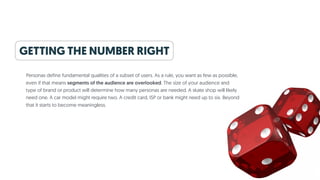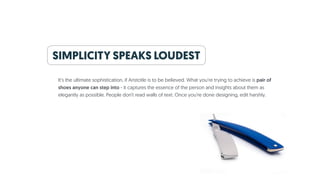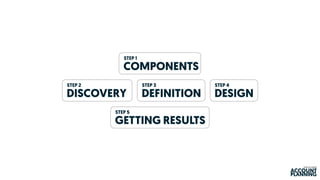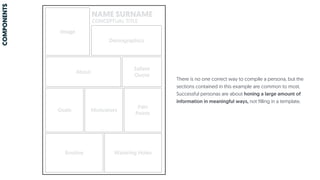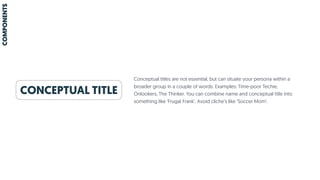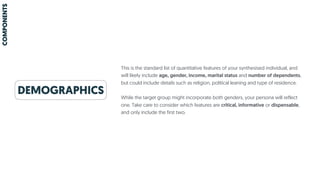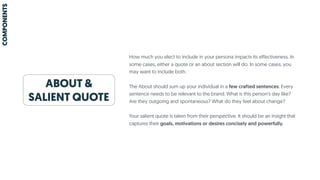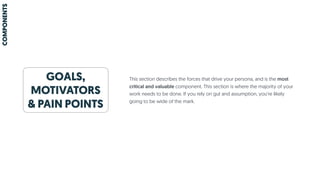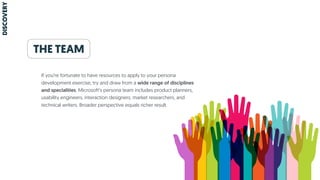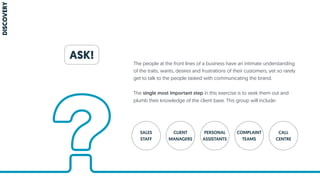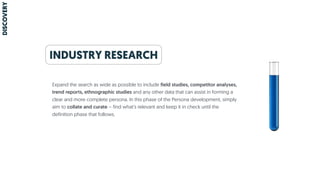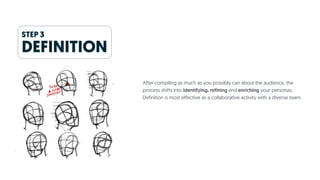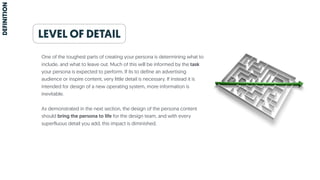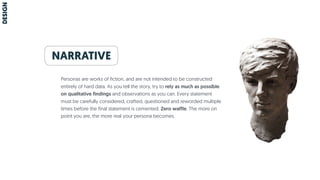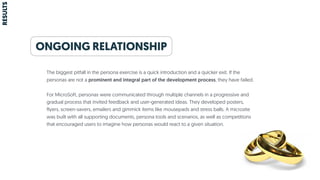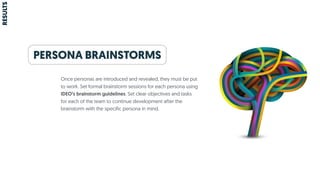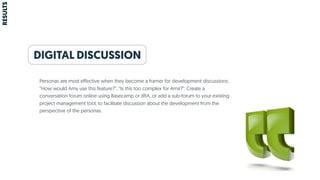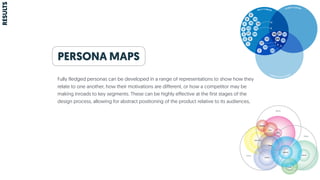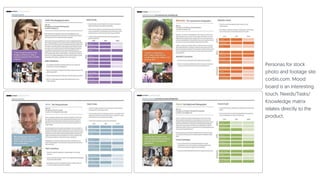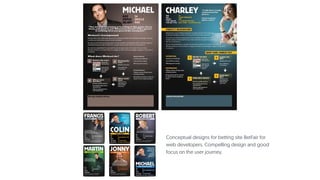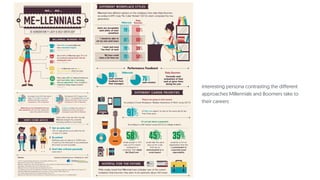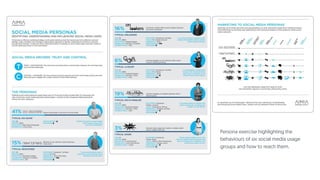Creating Powerful Personas
- 1. ACCOUNT Tools for better PLANNING Targeting the people that matter most CORE TO AURA CREATING POWERFUL PERSONAS
- 2. ACCOUNT Tools for better PLANNING Personas change the perspective to simplify design and development decisions. By creating a concept consumer, we uncover valuable insights that provide development teams with fertile ground to create. WHY CREATE PERSONAS? I think it should be designed like this BECOMES Let’s design it the way our guy would use it
- 3. WHO USES THEM & WHY Personas are today used extensively in some of the world most forward thinking organisations to create a closer connection with the audiences that matter most. Personas help marketing teams bridge the gap between the desires, needs and expectations of customers on one hand, and the product team’s assumptions on the other.
- 4. ACCOUNT Tools for better PLANNING The power of personas is their ability to distil a wide variety of traits and statistics into a composite, much like a police sketch. And as with the police sketch, a poor likeness yields poor results. A persona constructed out of assumption is worse than useless, it’s likely to be counter-productive. A WORD OF CAUTION
- 5. Personas define fundamental qualities of a subset of users. As a rule, you want as few as possible, even if that means segments of the audience are overlooked. The size of your audience and type of brand or product will determine how many personas are needed. A skate shop will likely need one. A car model might require two. A credit card, ISP or bank might need up to six. Beyond that it starts to become meaningless. GETTING THE NUMBER RIGHT
- 6. It’s the ultimate sophistication, if Aristotle is to be believed. What you’re trying to achieve is pair of shoes anyone can step into - it captures the essence of the person and insights about them as elegantly as possible. People don’t read walls of text. Once you’re done designing, edit harshly. SIMPLICITY SPEAKS LOUDEST
- 7. STEP 2 DISCOVERY STEP 3 DEFINITION STEP 4 DESIGN STEP 1 COMPONENTS STEP 5 GETTING RESULTS ACCOUNT Tools for better PLANNING
- 8. STEP 1 COMPONENTS The big goal is to create a persona that reflects the archetype of each audience accurately.. There is no set-in-stone template. I generally modify my personas according to the brand - a soft-edged consumer brand might have a longer-form storytelling style, where a B2B product will have more data points and bullet lists.
- 9. COMPONENTS NAME SURNAME CONCEPTUAL TITLE Demographics Image About Salient Quote Goals Motivators Pain Points Routine Watering Holes There is no one correct way to compile a persona, but the sections contained in this example are common to most. Successful personas are about honing a large amount of information in meaningful ways, not filling in a template.
- 10. COMPONENTS IMAGE The image instantly contextualises your persona – demographics, personality and style. Collect a folder of potential candidates and shortlist by elimination. Try to avoid posed images and the facetious ‘stock image’ look, Look for a shot that’s in the moment.
- 11. COMPONENTS NAME SURNAME What’s in a name? Name should of course be appropriate to race, nationality, age and gender, but can also infer character and personality traits (picture the people behind the names ‘Candy’, ‘Katherine’ and ‘Maude’)
- 12. COMPONENTS CONCEPTUAL TITLE Conceptual titles are not essential, but can situate your persona within a broader group in a couple of words. Examples: Time-poor Techie, Onlookers, The Thinker. You can combine name and conceptual title into something like ‘Frugal Frank’. Avoid cliche’s like ‘Soccer Mom’.
- 13. COMPONENTS DEMOGRAPHICS This is the standard list of quantitative features of your synthesised individual, and will likely include age, gender, income, marital status and number of dependents, but could include details such as religion, political leaning and type of residence. While the target group might incorporate both genders, your persona will reflect one. Take care to consider which features are critical, informative or dispensable, and only include the first two.
- 14. COMPONENTS ABOUT & SALIENT QUOTE How much you elect to include in your persona impacts its effectiveness. In some cases, either a quote or an about section will do. In some cases, you may want to include both. The About should sum up your individual in a few crafted sentences. Every sentence needs to be relevant to the brand. What is this person’s day like? Are they outgoing and spontaneous? What do they feel about change? Your salient quote is taken from their perspective. It should be an insight that captures their goals, motivations or desires concisely and powerfully.
- 15. COMPONENTS GOALS, MOTIVATORS & PAIN POINTS This section describes the forces that drive your persona, and is the most critical and valuable component. This section is where the majority of your work needs to be done. If you rely on gut and assumption, you’re likely going to be wide of the mark.
- 16. COMPONENTS DAILY ROUTINE & WATERING HOLES These sections are non-essential, and will largely be determined by your intent in creating the personas. For communications and advertising, they are usually essential, less so for product development or retail experiences. This area of the persona looks at where your audience is finding their information, what influences their decision making, and the intersections in their everyday where large swathes of them can be reached.
- 17. COMPONENTS NAME SURNAME JOB TITLE Overview Image A Day in the Life Work Activities Leisure Activities Goals Fears Aspirations Computer Skills Technology Attributes An alternative persona developed by Microsoft. Emphasis on technology and international variations of the persona reflect their business. Every Microsoft persona is backed by an in-depth research dossier. Quotes International Differences Demographics
- 18. STEP 2 DISCOVERY In most cases, a brand or product will include a prescribed target. While this can be a good starting point, and will likely have a close semblance to your final persona, I recommend ignoring the given audience, and developing the persona from scratch. ACCOUNT Tools for better PLANNING
- 19. DISCOVERY THE TEAM If you’re fortunate to have resources to apply to your persona development exercise, try and draw from a wide range of disciplines and specialities. Microsoft’s persona team includes product planners, usability engineers, interaction designers, market researchers, and technical writers. Broader perspective equals richer result.
- 20. DISCOVERY The people at the front lines of a business have an intimate understanding of the traits, wants, desires and frustrations of their customers, yet so rarely get to talk to the people tasked with communicating the brand. The single most important step in this exercise is to seek them out and plumb their knowledge of the client base. This group will include: ASK! SALES STAFF CLIENT MANAGERS PERSONAL ASSISTANTS COMPLAINT TEAMS CALL CENTRE
- 21. DISCOVERY FOCUS GROUP If you’re fortunate to have the budget and time to assemble a focus group, it is an invaluable resource for honing your persona. More often, focus groups will be assembled for other reasons. Throw in some of the questionnaire questions that follow as an introduction. Also, find out if any videos exist from past focus group and look there for insights.
- 22. DISCOVERY Online surveys are most effective when you have direct access to a database of existing clients, but can also work by approaching communities that fall within primary or secondary audiences. Facebook and LinkedIn groups, hobbyist sites and industry portals all offer access. Vet the results carefully and weed out responses from individuals not within the target parameters. ONLINE SURVEY ACCOUNT Tools for better PLANNING
- 23. DISCOVERY To uncover the right information, you have ask the right questions. Tailor your own questionnaire to the specifics of your brand or product, in addition to: • The demographic profiles of the average customer, including age, gender, education, income, marital status, number of dependents etc. • Employment, career path and company profile • What happens in their typical day? • Where do they aspire to be in 5 years? Where are they likely to be then? • What are their major challenges and complaints? • How tech savvy are they? • How open are they to change and new ideas? • What drives and motivates them? What does success mean to them? • What social media are they on? What sites do they frequent? • What associations do they belong to? • Where do they get their information about the business? • What are their shopping habits? Online or brick & mortar? • What do they watch and read? • What do they do to relax? QUESTIONNAIRE
- 24. DISCOVERY WEB ANALYTICS Google Analytics offers a wealth of insightful information about the demographics, browsing behaviour, interests and trends of the visitors to your company website. Breaking this down into the pages each group browse is an invaluable source of primary data for persona development.
- 25. DISCOVERY Expand the search as wide as possible to include field studies, competitor analyses, trend reports, ethnographic studies and any other data that can assist in forming a clear and more complete persona. In this phase of the Persona development, simply aim to collate and curate – find what’s relevant and keep it in check until the definition phase that follows. INDUSTRY RESEARCH
- 26. STEP 3 DEFINITION After compiling as much as you possibly can about the audience, the process shifts into identifying, refining and enriching your personas. Definition is most effective as a collaborative activity with a diverse team.
- 27. DEFINITION IDENTIFICATION A successful persona emerges like a bust from a block of marble. Identification is the first rough shape. Usually, by the end of the Discovery phase, you’ll have a strong idea of the number of personas and their characteristics by this stage. Find a wall or whiteboard and divide it into the number of personas you’re creating, and place a conceptual title for each one in the centre.
- 28. DEFINITION PROCESS The power of personas comes through accuracy and refinement. Although you might have a ton of exciting data compiled on your individual, the magic comes in identifying what matters and polishing that to a high shine. Colour coding the information on stickies and putting it all in front of you is a great starting point before whittling it down to the gems. ACCOUNT Tools for better PLANNING
- 29. DEFINITION LEVEL OF DETAIL One of the toughest parts of creating your persona is determining what to include, and what to leave out. Much of this will be informed by the task your persona is expected to perform. If its to define an advertising audience or inspire content, very little detail is necessary. If instead it is intended for design of a new operating system, more information is inevitable. As demonstrated in the next section, the design of the persona content should bring the persona to life for the design team, and with every superfluous detail you add, this impact is diminished.
- 30. DEFINITION SANITY CHECK You’re done with compiling your persona, and you believe you’ve got it spot on. A sanity check is a great way to ensure your high level characteristics align with the detail you’ve included, particularly if you’ve had to rely on more guesswork than you’d have liked. One way to do this is to try and find a few real life archetypes. Run your persona by them and see whether everything resonates. Push them to be honest, and dig deep on the sticking points. The bigger your sample here the better. ACCOUNT Tools for better PLANNING
- 31. STEP 4 DESIGN The rise of digital means that design has a greater role to play in business today than at any point before. This isn’t simply about how something looks, but about how it works, how it communicates. Design is a critical to the success of your persona. How the information is presented will determine how it is viewed, interpreted and put to work. It will provide credibility. If you are not skilled in design, I strongly recommend bringing a graphic designer in to deliver the final product. It makes a world of difference.
- 32. DESIGN RESONANCE The impact your persona ultimately makes is largely down to how well it is represented. As seen in the examples at the end of this presentation, the quality of the design and layout has a significant impact on how it is perceived. If you can’t have a professional help you, draw inspiration from well designed personas, and carefully consider every aspect of the design, from the fonts and image placement to the data visualisations.
- 33. DESIGN INFOGRAPHICS Nothing kills a persona faster than a bland wall of text. With a good designer, the information in your persona can be transformed into a visual language that gets the message across faster and more powerfully than text alone. Infographics can compress masses of data into a simple illustration, it can give abstract concepts meaning and can draw the eye from section to section in a logical progression.
- 34. NARRATIVE Personas are works of fiction, and are not intended to be constructed entirely of hard data. As you tell the story, try to rely as much as possible on qualitative findings and observations as you can. Every statement must be carefully considered, crafted, questioned and reworded multiple times before the final statement is cemented. Zero waffle. The more on point you are, the more real your persona becomes. DESIGN
- 35. SUPPORTING DATA DESIGN The more in depth your persona is, the more research and background information you will have to support it. This can be invaluable to the user in the steps that follow, so categorising, referencing, filing and attaching this information to your persona is a must. Include all video of interviews and focus groups, and use a footnote system to direct the reader to the relevant documents.
- 36. STEP 5 So you’ve poured passion and sweat into creating personas that resonate. Where to now? Personas will often meet stiff resistance, particularly in hard-nosed engineering or scientific workplaces. Develop a step-by-step plan for launching the personas internally, with a medium term plan for integrating them into the daily processes. GETTING RESULTS
- 37. RESULTS INTRODUCING PERSONAS I strongly suggest a two step approach. First, create a short, sharp presentation on what personas are, why they’re effective, and which companies are using them. There’s many great case studies online to back your argument. Second, don’t reveal everything at once. Start with the name and image of each. If you’ve got several, only introduce one per sitting. Aim to develop a first-name relationship between the audience and the persona, and build up the personality behind the persona over several days or weeks. How personas are introduced should be determined by the audience. If the team is marketing and design oriented, its likely that they’re going to be receptive; most other departments less so.
- 38. ONGOING RELATIONSHIP The biggest pitfall in the persona exercise is a quick introduction and a quicker exit. If the personas are not a prominent and integral part of the development process, they have failed. For MicroSoft, personas were communicated through multiple channels in a progressive and gradual process that invited feedback and user-generated ideas. They developed posters, flyers, screen-savers, emailers and gimmick items like mousepads and stress balls. A microsite was built with all supporting documents, persona tools and scenarios, as well as competitions that encouraged users to imagine how personas would react to a given situation. RESULTS
- 39. MAKE THEM VISIBLE Personas cannot make themselves felt hidden away in a folder or as digital files. Consider where and how personas will be used and produce materials to make them larger than life. If you can, use models from your stock photo provider with extensive photoshoots in different settings. Expand the salient quotes section, and create posters with a new quote each time. Find innovate ways to build the persona into the environment. RESULTS ACCOUNT Tools for better PLANNING
- 40. PERSONA BRAINSTORMS Once personas are introduced and revealed, they must be put to work. Set formal brainstorm sessions for each persona using IDEO’s brainstorm guidelines. Set clear objectives and tasks for each of the team to continue development after the brainstorm with the specific persona in mind. RESULTS
- 41. DIGITAL DISCUSSION Personas are most effective when they become a framer for development discussions: “How would Amy use this feature?”, “Is this too complex for Amir?”. Create a conversation forum online using Basecamp or JIRA, or add a sub-forum to your existing project management tool, to facilitate discussion about the development from the perspective of the personas. RESULTS
- 42. PRIORITY MATRIX The priority matrix is an excellent way to demonstrate the strength of personas, particularly in product development. Every feature of the product is scored according to how each persona would perceive and use it. Negative scores are given for features that would harm the user experience. Each persona is weighted by his or her importance to the business and size of market to ascertain which features should be pursued and which scrapped. RESULTS PERSONA 1 PERSONA 2 PERSONA 3 WEIGHTED WEIGHTING 60 25 15 FEATURE 1 0 2 1 65 FEATURE 2 2 -1 0 95 FEATURE 3 1 1 2 115
- 43. ENRICHMENT & EVOLUTION Solving and growing your persona is a great way to get them deeply imbedded into the creative process. Document the results of brainstorms and development were personas have been used, and publish them on the forum. Invite users to offer their own salient quotes. When new qualitative research emerges, use it to test the integrity of the personas, and tweak them to build a more rounded and accurate archetype. RESULTS
- 44. TESTIMONIALS Personas work incredibly well in creating brand-building campaigns using customer perspective as the concept. Testimonial style ads, online video, quotes and endorsement developed from robust personas will resonate with the consumers they are intended to represent. Personas ensure the target segments are on point, insights are built in, and multiple facets of the needs, frustrations and motivations of each group are clearly communicated. RESULTS
- 45. PERSONA MAPS Fully fledged personas can be developed in a range of representations to show how they relate to one another, how their motivations are different, or how a competitor may be making inroads to key segments. These can be highly effective at the first stages of the design process, allowing for abstract positioning of the product relative to its audiences, RESULTS
- 46. The following slides incorporate a range of persona styles and designs used by world leading companies. GREAT EXAMPLES
- 47. Personas for development of a car care app. Strong salient quote and good use of infographics but the description could be more concise.
- 48. Personas for stock photo and footage site corbis.com. Mood board is an interesting touch. Needs/Tasks/ Knowledge matrix relates directly to the product.
- 49. Fantastic persona set for Disney’s movie consumers. Each persona is distinct, clearly defined and contrasted with the others. Information is beautifully crafted and presented.
- 50. Conceptual designs for betting site BetFair for web developers. Compelling design and good focus on the user journey.
- 51. Persona development exercise for a graduate design portfolio. Refined, well designed and freshly presented.
- 52. Persona for American Express highlighting the usage patterns for their points rewards
- 53. Persona for Belkin Energy App
- 54. Interesting persona contrasting the different approaches Millennials and Boomers take to their careers
- 55. Another example with Millennials as customers. Headlines of each section are great examples of a lot of information distilled into a single phrase. Far more data driven than most personas.
- 56. Personas for Environ’s skincare range. Vertical design contrasts the differences between each group clearly.
- 57. Persona exercise highlighting the behaviours of six social media usage groups and how to reach them.





